Antibody data
- Antibody Data
- Antigen structure
- References [1]
- Comments [0]
- Validations
- Western blot [1]
- Immunocytochemistry [2]
- Immunohistochemistry [4]
- Other assay [2]
Submit
Validation data
Reference
Comment
Report error
- Product number
- PA5-57673 - Provider product page

- Provider
- Invitrogen Antibodies
- Product name
- SH3PXD2B Polyclonal Antibody
- Antibody type
- Polyclonal
- Antigen
- Recombinant protein fragment
- Description
- Immunogen sequence: PPGVILPMMP AKHIPPARDS RRPEPKPDKS RLFQLKNDMG LECGHKVLAK EVKKPNLRPI SKSKTDLPEE KPDATPQNPF LKSRPQV Highest antigen sequence identity to the following orthologs: Mouse - 78%, Rat - 80%.
- Reactivity
- Human
- Host
- Rabbit
- Isotype
- IgG
- Vial size
- 100 μL
- Concentration
- 0.1 mg/mL
- Storage
- Store at 4°C short term. For long term storage, store at -20°C, avoiding freeze/thaw cycles.
Submitted references Prognostic value of SH3PXD2B (Tks4) in human hepatocellular carcinoma: a combined multi-omics and experimental study.
Kui X, Wang Y, Zhang C, Li H, Li Q, Ke Y, Wang L
BMC medical genomics 2021 Apr 28;14(1):115
BMC medical genomics 2021 Apr 28;14(1):115
No comments: Submit comment
Supportive validation
- Submitted by
- Invitrogen Antibodies (provider)
- Main image
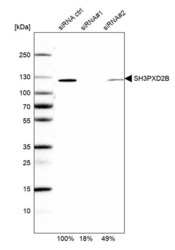
- Experimental details
- Western blot analysis of SH3PXD2B in U2OS cells transfected with control siRNA, target specific siRNA probe #1 and #2, using a SH3PXD2B Polyclonal Antibody (Product # PA5-57673). Remaining relative intensity is presented. Loading control: Anti-GAPDH.
Supportive validation
- Submitted by
- Invitrogen Antibodies (provider)
- Main image
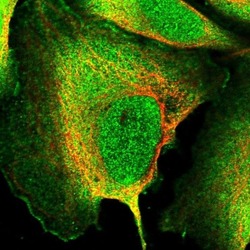
- Experimental details
- Immunofluorescent staining of SH3PXD2B in human cell line U-2 OS using a SH3PXD2B Polyclonal Antibody (Product # PA5-57673) shows localization to nucleus and plasma membrane.
- Submitted by
- Invitrogen Antibodies (provider)
- Main image
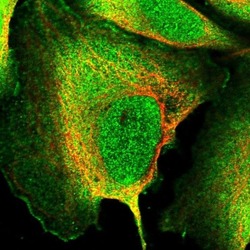
- Experimental details
- Immunofluorescent staining of SH3PXD2B in human cell line U-2 OS using a SH3PXD2B Polyclonal Antibody (Product # PA5-57673) shows localization to nucleus and plasma membrane.
Supportive validation
- Submitted by
- Invitrogen Antibodies (provider)
- Main image
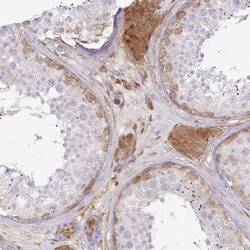
- Experimental details
- Immunohistochemical analysis of SH3PXD2B in human testis using SH3PXD2B Polyclonal Antibody (Product # PA5-57673) shows strong cytoplasmic positivity in Leydig cells.
- Submitted by
- Invitrogen Antibodies (provider)
- Main image

- Experimental details
- Immunohistochemical analysis of SH3PXD2B in human Fallopian tube using SH3PXD2B Polyclonal Antibody (Product # PA5-57673) shows moderate cytoplasmic positivity in glandular cells.
- Submitted by
- Invitrogen Antibodies (provider)
- Main image
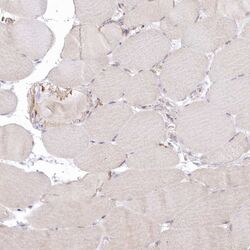
- Experimental details
- Immunohistochemical analysis of SH3PXD2B in human skeletal muscle using SH3PXD2B Polyclonal Antibody (Product # PA5-57673) shows low expression in myocytes as expected.
- Submitted by
- Invitrogen Antibodies (provider)
- Main image
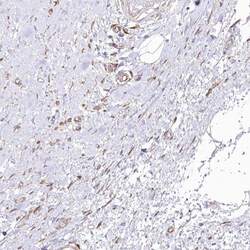
- Experimental details
- Immunohistochemical staining of SH3PXD2B in human soft tissue using a SH3PXD2B Polyclonal Antibody (Product # PA5-57673) shows moderate cytoplasmic positivity in fibroblasts.
Supportive validation
- Submitted by
- Invitrogen Antibodies (provider)
- Main image
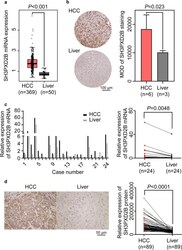
- Experimental details
- Fig. 1 SH3PXD2B expression is up-regulated in HCC tissues. The levels of SH3PXD2B mRNA transcripts and protein expression in HCC tissues of the TCGA database ( a ) and the Human Protein Atlas ( b ) were analyzed. c The relative levels of SH3PXD2B mRNA transcripts in 24 pairs of freshly surgical HCC and paired non-tumor liver tissues were analyzed by qRT-PCR. d Immunohistochemical analysis of 89 pairs of HCC and non-tumor liver samples. Data are representative images (magnification x 200) or expressed as the mean values in individual samples or mean +- SD of each group
- Submitted by
- Invitrogen Antibodies (provider)
- Main image
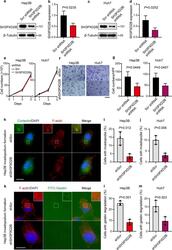
- Experimental details
- Fig. 3 SH3PXD2B silencing inhibits the invasion, but not proliferation of Hep3B and Huh7 cells. Hep3B and Huh7 cells were transduced with lentivirus for expression of SH3PXD2B-specific shRNA or control shRNA (Scr). The relative levels of SH3PXD2B to the control beta-tubulin protein expression in different groups of Hep3B ( a , b ) and Huh7 ( c , d ) cells were determined by Western blot. e The dynamic proliferation of Hep3B and Huh7 cells was determined at the indicated time points. f , g The invasion of different groups of Hep3B and Huh7 cells was examined by transwell invasion assays. h - j The formation of invadopodia in different groups of Hep3B and Huh7 cells was examined by immunofluorescence assays. k - m The function of invadopodia in different groups of Hep3B and Huh7 cells was examined by in situ zymography. A total of 150 cells per group were analyzed by two researchers in a blinded manner. Data are representative images or expressed as the mean +- SD of each group from three separate experiments. Bar scale in F = 100 mum. Bar scales in H and K = 20 mum
 Explore
Explore Validate
Validate Learn
Learn Western blot
Western blot